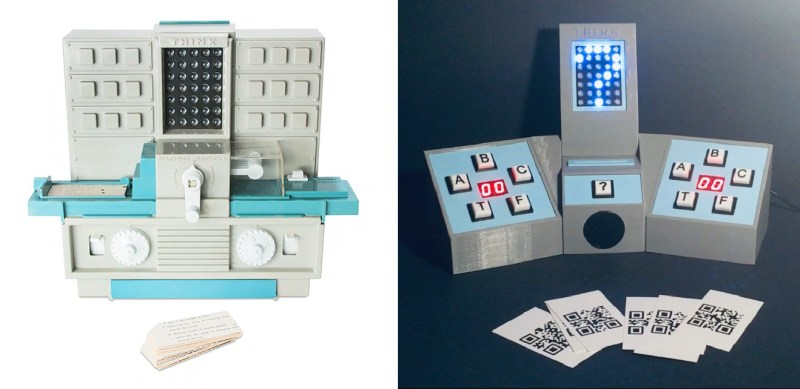I've posted several times about the re-creations of 1960s computer toys and educational games that my talented cousin, Michael Gardi, has been producing over the last few years. He has a new project, an updated version of Hasbro's Think-a-Tron, a "computerized" trivia game I put "computerized" in quotes because, as you'll see from Michael's article, it was not computerized at all, but just made to look like one.
Ok, my elevator pitch for this project is just a "bit" overstated, but so was the marketing for Think-a-Tron, "the machine that thinks like a man". While some toys of the same era, like the Digi-Comp I for instance, endeavored to teach people about computers, Think-a-Tron took advantage of the growing interest in computers to sell a cleverly packaged trivia game. In fact, if there is any "claim to fame" attached to Think-a-Tron, it's that it introduced the trivia game concept 21 years before Trivial Pursuit.
My goal for this project is to honor Think-a-Tron, not to reproduce it. I want to build something that is clearly a Think-a-Tron derivative, but utilizes modern fabrication techniques and components. At the same time I would like to maintain the 60s mainframe vibe of the original. As always I want to have some fun along the way.
Hackaday has this to say about it.
In an effort to right past wrongs, [Michael Gardi] rebuilt the 1960s “thinking machine” toy with modern components. The original may not have lived up to the hype, but at least did a decent job of evoking the room-filling computers of the day is a plastic cabinet with a dot-matrix-like display. The toy uses “punch-cards” with printed trivia questions that are inserted into the machine to be answered. A disk with punched holes spins between a light bulb and the display lenses, while a clever linkage mechanism reads the position of a notch in the edge of the card and stops the wheel to display the letter of the correct answer.
[Michael]’s update to the Think-aTron incorporates what would have qualified as extraterrestrial technology had it appeared in the 1960s. A 35-LED matrix with a 3D-printed diffuser and case form the display, with trivia questions and their answer as a QR code standing in for the punch-cards.He also added a pair of user consoles, so players can lock-in and answer before an ESP32-Cam reads the QR code and displays the answer on the LED matrix, after playing some suitable “thinking music” through a speaker.
Update: Mike has created a follow-up project, the Think-a-Tron Mini.

No comments:
Post a Comment